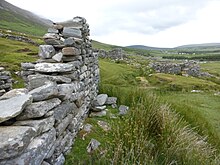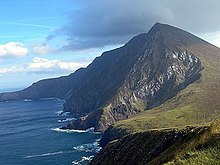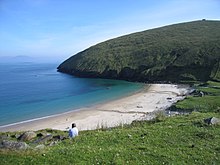Achill Island
The hereditary chieftains of Umhall were the O'Malleys, recorded in the area in 814 AD when they successfully repelled an incursion by Viking attackers in Clew Bay.The Butler Lordship of Burrishoole continued into the late 14th century when Thomas le Botiller was recorded as being in possession of Akkyll and Owyll.[13] In 1848, at the height of the Great Famine, the Achill Mission published a prospectus seeking to raise funds for the acquisition of significant additional lands from Sir Richard O'Donnell.The document gives an overview, from the Mission's perspective, of its activities in Achill over the previous decade and a half including considerable sectarian unrest.This term referred to the temporary accommodation provided for those who went to Scotland to pick potatoes, a migratory pattern that had been established in the early nineteenth century.The present church was built in the 1700s and the graveyard contains memorials to the victims of two of Achill's greatest tragedies, the Kirchintilloch Fire (1937) and the Clew Bay Drowning (1894).In 1852, John MacHale, Roman Catholic Archbishop of Tuam, purchased land in Bunnacurry, on which a Franciscan Monastery was established, which, for many years, provided an education for local children.He wrote a biography of James Lynchehaun who was convicted for the 1894 attack on an Englishwoman named Agnes MacDonnell, which left her face disfigured, and the burning of her home, Valley House, Tonatanvally, North Achill.Carney's great-grandniece, Patricia Byrne, wrote her own account of Mrs MacDonnell and Lynchehaun, entitled The Veiled Woman of Achill.Its notoriety arises from an incident in 1894 in which the then owner, an Englishwoman, Mrs Agnes McDonnell, was savagely beaten and the house set alight by a local man, James Lynchehaun.After the events at the Valley House in 1895, Lynchehaun would falsely claim his actions were carried out on behalf of the Irish Republican Brotherhood and motivated by politics.He escaped from custody after serving seven years[23] and fled to the United States seeking political asylum (although Michael Davitt refused to shake his hand, calling Lynchehaun a "murderer"), where he successfully defeated legal attempts by the British authorities to have him extradited to face charges arising from the attack and the burning of the Valley House.[25] This means that during the summer season, the younger members of the family, teenage boys and girls, would take the livestock to the area and tend flocks or herds on the hillside and stay in the houses of the Deserted Village.[citation needed] In 2009, a summer field school excavated Round House 2 on Slievemore Mountain under the direction of archaeologist Stuart Rathbone.The Congested Districts Board for Ireland (CDB) subsidised the building of new, more spacious (though still small by modern standards) homes outside of the traditional villages.An old British observation post, built during World War I to prevent the Germans from landing arms for the Irish Republican Army, still stands on Moytoge.West of this ruined village is an old Martello tower, again built by the British to warn of any possible French invasion during the Napoleonic Wars.While a number of attempts at setting up small industrial units on the island have been made, its economy is largely dependent on tourism.The island's Atlantic location means that seafood, including lobster, mussels, salmon, trout and winkles, are common.[38] Within the emerging Irish Free State, Paul Henry's landscapes from Achill and other areas reinforced a vision of Ireland of communities living in harmony with the land.[39] He lived in Achill for almost a decade with his wife, artist Grace Henry and, while using similar subject-matter, the pair developed very different styles.[45] The Great Western Greenway, created during 2010 and 2011, follows the line's route[46] and has proved to be very successful in attracting visitors to Achill and the surrounding areas.[50] Achill Island's rugged landscape and the surrounding ocean offers multiple locations for outdoor adventure activities, like surfing, kite-surfing and sea kayaking.[citation needed] Sailing regattas featuring a local vessel type, the Achill Yawl, have been run since the 19th century.










A'ChillTopographyAtlantic OceanCroaghaunIrelandProvinceConnachtCountyBaronyBurrishoolehistorical baronyCounty MayoIrish islesMichael Davitt BridgeAchill SoundPolrannyDooaghDooegaDooniverDugortpeat bogsBun an ChurraighGaeltachtEnglishcivil parishAchillbegInishbiggleCorraun PeninsulaElizabeth ThompsonNeolithic Periodcrop cultivationIron Agepromontory fortsMegalithic tombsUmhallCounty GalwayClew BayAnglo-NormanUlsterdialectsOrdnance SurveyUlster IrishsuperstratumConnacht IrishEast LothianpotatoesKirkintillochbridgeCarrickkildavnet CastleGrace O' MalleyClare IslandMurriskQueen Elizabeth IChurch of IrelandEdward NanglesouperismAchill Missionary Herald and Western WitnessBrian Rua O' CearbhainDymphnaJohn MacHaleBunnacurryTonatanvallyMichael DavittSlievemorelazy bedsrundaletend flocks or herdstranshumanceChuck MeideCollege of William and MaryLighthouse Archaeological Maritime Program (LAMP)currachCongested Districts Board for IrelandKeem BayCaisleán GhráinneEuropetouristssurfingWorld War IGermansIrish Republican Armythe Emergency (WWII)abandoned villageMartello towerNapoleonic WarsNeolithic tombJohnny KilbaneGrace O'MalleyRockfleet Castletourismfishingbasking sharkshark liver oilAtlanticlobstermusselssalmonwinklesRoman CatholicchurchesSaint JosephsThe ValleyPollaghHouse of Prayerlandscape painterPaul HenryGrace HenryEva O'FlahertyMarie HowetRobert HenriMainie JellettCamille SouterGeraldine O'ReillyAlanna O'KellyAlexander Williamssecondary schoolsColáiste Pobail Aclanational schoolsAchill railway stationMidland Great Western RailwayWestportNewportMulrannyGreat Southern RailwaysGreat Western GreenwayR319 road
